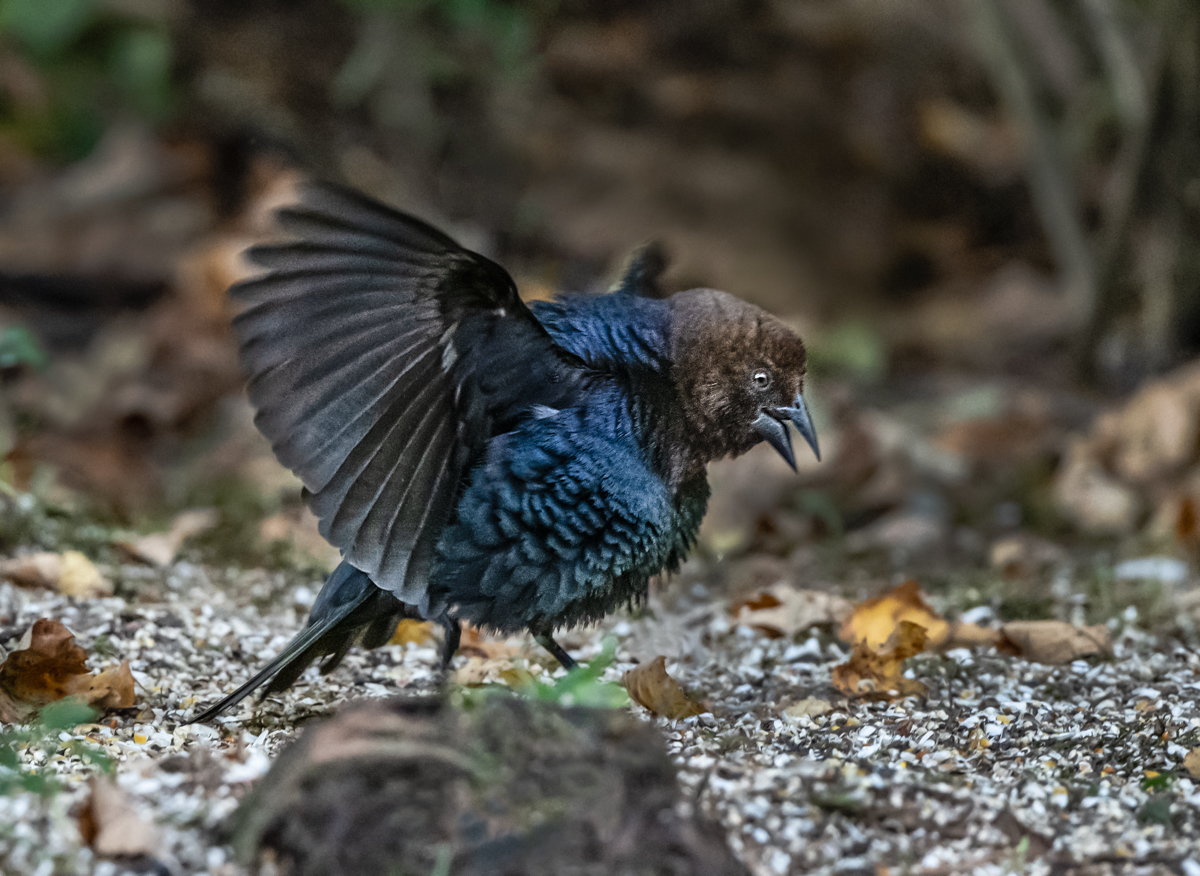
In North America, the Brown-headed Cowbird is a familiar common bird often seen in large flocks, hanging out with similar species such as Red-winged Blackbirds and Common Grackles. They are slightly smaller than the blackbirds and grackles, males are black with a namesake brown hood, females and immatures are nondescript dull brown birds. Many bird lovers who feed birds in the backyard dislike cowbirds, grackles, and blackbirds due to their tendency of arriving at feeders in large numbers, eating massive quantities of food, and keeping the more popular species like cardinals, finches and chickadees at bay. However, there is an additional reason why the cowbird is often considered the biggest villain of them all.
Unlike the blackbirds and grackles that raise their own young, Brown-headed Cowbirds hold a rather sinister secret – they do not raise their own young, instead, they lay an egg in other birds’ nests and play zero part in the upbringing of their young. For this reason, they can often be thought of as a villain within the bird world. This behavior is known as brood parasitism. The Cowbird is a native to American fauna, however, they were not always as common as they appear to be today. The breeding strategy of laying eggs in other birds’ nests developed way before the first European settlers arrived. It was actually a very clever strategy as the cowbird would follow the great herds of bison around the great plains, feeding on the insects and seeds that the herds would kick up. (You may see cowbirds nowadays continuing this behavior with farm cattle herds). As the bison herds never stayed put for very long the cowbirds did not have enough time to raise a family, therefore they’d leave an egg in another bird’s nest to hatch and feed the chick for them.
The population of cowbirds increased massively after the European settlers arrived, the settlers cleared large areas of forests and created open areas that the cowbird would find to their liking, the settlers had farms with livestock that did not continually move, and they no longer had the need to travel around but their breeding strategy did not change. The opening of land continues today and cowbirds will be one of the first species to exploit it. Cowbirds have been recorded laying their eggs in over 220 species of birds including bizarre hosts such as hawks or hummingbirds. Of those species over 140 have been known to raise the cowbird chick to fledge. Some of the more popular species that cowbirds use are Yellow, Warbler, Song Sparrow, Chipping Sparrow, Ovenbird, Yellow-breasted Chat and Red-winged Blackbird.
Female cowbirds will search for host nests by sitting on top of prominent perches and observing the comings and goings of birds in the area. Once a suitable nest is found it will lay one egg in the nest, the egg does not try to imitate the color or shape of the host species – a risky strategy. Sometimes the host will notice the strange egg in their nest, on these occasions the host may abandon the nest including their own eggs, destroy the egg, and even bury the egg within the nest and continue to incubate their own eggs. In fact, if a cowbird lays an egg in a Gray Catbird nest it has a 95% chance of being rejected. According to at least one study, Cowbirds will periodically check on their eggs, if they find their egg has been removed or destroyed by the host they will likely destroy the host’s nest forcing the host to rebuild a new nest and in turn, the Cowbird will re-lay an egg in the new nest more than 85% of the time. This retaliatory reaction is termed ‘mafia’ behavior.
Many bird lovers who notice or find a cowbird egg in one of their beloved garden birds’ nests are often tempted to remove it – this is not only a bad idea as described by the mafia behavior above but it is also illegal as the Brown-headed Cowbird is protected under the Migratory Bird Treaty Act, and taking eggs is illegal without a permit. Occasionally there are instances when permits are granted, such as the control of cowbirds in areas of endangered species – the conservation of the Kirtland’s Warbler being a high-profile example.
When the egg has successfully hatched, the chick will dominate the nest, generally being the loudest, largest, and most demanding of the chicks, and therefore will receive most of the food that the host parents bring to the nest. Sometimes the chick will be twice the size of the host parents. Unlike the most famous brood parasite, the Common Cuckoo (from Europe), the cowbird chick does not eject its adopted siblings from the nest; as long as there is enough food being brought to the nest there is a chance that all will survive, if food is scarce it will be the larger and louder cowbird chick that out-competes the others.
On a recent trip to Arizona, Owen photographed a recently fledged Brown-headed Cowbird being fed by its host parent, a Vermilion Flycatcher at the wonderful Casa de San Pedro. The size difference is quite apparent and was rather comical to observe.


